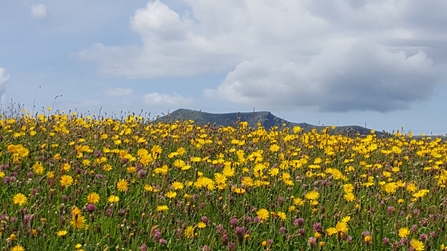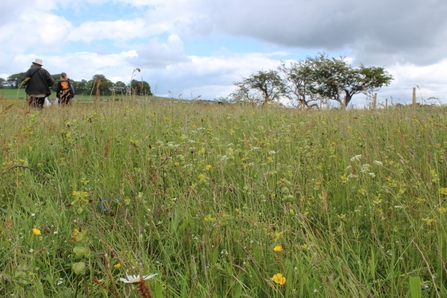
Wildflower meadow at Eycott Hill Nature Reserve, with Blencathra in the distance © Cumbria Wildlife Trust

Wildflower meadow at Eycott Hill Nature Reserve, with Blencathra in the distance © Cumbria Wildlife Trust
Ten years ago, in 2013 the former Prince of Wales launched Coronation Meadows to honour the 60th year of the late Queen’s accession to the throne.
In the face of the catastrophic loss of 97% of our wildflower meadows since the 1930s, the plan was to create new and restored meadows using donor seed from remaining fragments of ancient and traditional meadows.
The Wildlife Trusts and Plantlife – charities for whom the former Prince of Wales was patron – worked together to identify 60 species-rich meadows which are known as Coronation Meadows, one for every year of the Queen’s reign at that time. These special places became donors to provide precious seed to increase the amount of valuable and beautiful wildflower habitat elsewhere.
The charities have done an audit of the success of the project which reveals that a fantastic 101 new wildflower meadows have been created or restored since the Coronation Meadows project began a decade ago.
We are delighted that the Coronation Meadows project has increased the number of wildflower meadows and benefitted a vast array of wildlife, from bees and butterflies to bats and birds. The area is still expanding as the charities continue to harvest and spread the wildflower seed in localities close to the original sites so that the distinctive character of each area’s flora is preserved.
Biffa Award, through the Landfill Communities Fund, contributed £1million to fund the equipment and training needed for meadow restorations. In the first three years of the project alone, more than 700 volunteers gave their time to get the project off the ground. Seed was harvested from Coronation Meadows donor sites either as green hay (wildflowers and grasses which are harvested just as they are shedding seed and still 'green'), brush harvested seed or by hand, and this was used to seed second sites in the same area.
These are some of the most vulnerable of all habitats in our county ... It's a privilege for us to be looking after this precious part of our living heritageStephen Trotter, CEOCumbria Wildlife Trust

Eycott Hill Coronation Meadow one year on © Cumbria Wildlife Trust
In 2014 we created a Coronation Meadow at Eycott Hill Nature Reserve near Mungrisdale, by restoring and enhancing an existing meadow with seeds from the wonderful Coronation Meadow at Piper Hole, Ravenstonedale. This special upland nature reserve is an awe-inspiring location, sitting in the shadow of Blencathra and on the site of an extinct volcano. The Coronation Meadow has been added to over the years and is now about eight hectares in size – that’s nearly 20 acres. The meadow now boasts autumn hawkbit, melancholy thistle and eyebright and is increasing in flora every year.
We also worked with the local community at Orton, near Tebay to create a small Coronation Meadow at Carsa Brow, with green hay and seed also from Piper Hole. The meadow is owned by the village and used as a piece of grazing land, and for its hay which is taken once a year in late summer, as well as being used by local people as a quiet place for recreation. When it was created, people from the village came out to spread it over the field by hand and with rakes. The local school children helped to plant wild flower plug plants after the hay had been spread and the meadow is developing well.
Stephen Trotter, CEO, Cumbria Wildlife Trust said: “It’s wonderful to be celebrating a decade of these fantastic Coronation Meadows in Cumbria and to see how well they’re thriving. We have an amazing variety of wild pollinators, from bumblebees, hoverflies and solitary bees, to butterflies and moths. They all depend on flower-rich habitat to survive. The loss of this precious habitat, mainly through changes in farming practices, has sadly led to their decline.
“The amazing meadows like those at Eycott Hill and at Bowber Head Farm, one of our newest nature reserves in the Westmorland Dales, are some of the most vulnerable of all habitats in our county. They’re now genuinely rare in Cumbria and the North of England, with the vast majority having disappeared over the last 100 years. It's a privilege for us to be looking after this precious part of our living heritage, and to be working closely with farmers and other partners, over a wide number of grassland sites across the county, to help ensure that they survive for future generations.”
Ian Dunn, CEO, Plantlife, said: “If you can, this Coronation year, make the opportunity to sit within an area of meadow or uncut grass. Look around at the colours and variety of plants. Then close your eyes and sense your surroundings through sound and smell. You’ll be amazed, reconnected with nature and feel just fantastic!
“We know healthy habitats such as meadows form the foundations of all successful conservation, as well as being at the roots of a healthy society and in addressing the climate challenges we face. At Plantlife we aspire to create a combined area equal to 20,000 new football fields of meadows before the end of this decade to give everyone the chance of experiencing the beauty and wildlife-rich meadows that were once commonplace. The exquisite Coronation meadows started 10 years ago give us confidence we can do so”.
We're working with partners across Cumbria, including farmers and local communities, to restore and connect fragmented habitats and put wildlife back into our nature-depleted landscape.
Plantlife is the global voice for wild plants and fungi, with 17,000 members and supporters and 23 nature reserves covering nearly 4,500 acres across England, Scotland and Wales.
Plantlife enhances, restores, protects and celebrates our natural heritage through working with landowners, other conservation organisations, public and private bodies and the wider public to secure a world rich in wild plants and fungi. A registered charity, Plantlife is funded by individual donations, through grants and charitable trusts and through its pioneering land management advice and projects. www.plantlife.org.uk
Biffa Award Since 1997, Biffa Award has awarded grants totalling more than £189million to thousands of worthwhile community and environmental projects across England, Scotland, Wales and Northern Ireland. The programme administers money donated by Biffa Group Ltd through the Landfill Communities Fund. www.biffa-award.org
Landfill Communities Fund (LCF) is an innovative tax credit scheme enabling operators (LOs) to contribute money to organisations enrolled with ENTRUST as Environmental Bodies (EBs). EBs use this funding for a wide range of community and environmental projects in the vicinity of landfill sites. LOs are able to claim a credit (currently 5.3%) against their landfill tax liability for 90% of the contributions they make. Since its inception in 1996, over £1.6 billion has been spent on more than 56,000 projects across the UK. For further information please visit Entrust or see HMRC’s general guide to landfill tax.